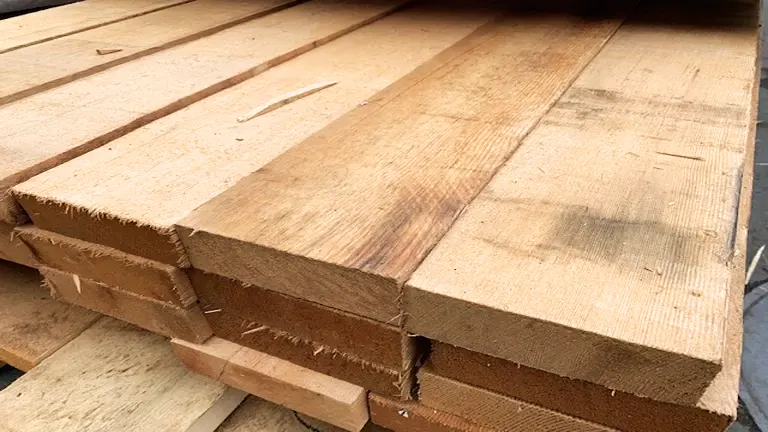Alder Lumber
- August 8, 2023
- 0 comment
Alder lumber is sourced from several species of alder trees, and its popularity in woodworking and construction stems from its versatility and attractive aesthetics. The wood’s relatively light color and subtle grain patterns contribute to its widespread use in crafting furniture, cabinets, and interior trim.

Renowned for its ease of workability, alder proves to be a delight for both professional woodworkers and hobbyists. Its moderate hardness and stability make it a reliable choice for various applications, striking a balance between strength and ease of manipulation.
Whether it’s intricate detailing or straightforward construction, alder proves to be a trustworthy material that can be shaped and crafted with precision, ensuring successful completion of a diverse array of projects. From intricate carvings to clean, contemporary designs, alder’s appeal is evident in its adaptability to suit various styles and tastes in the woodworking world.
| Common Name(s) | Alder |
|---|---|
| Scientific Name | Alnus spp. |
| Distribution | North America, Europe, and Asia |
| Tree Size | 50-80 feet tall, 1.5-3 feet in diameter |
| Average Dried Weight | 28-35 lbs/ft^3 (450-560 kg/m^3) |
| Specific Gravity | 0.45-0.56 |
| Janka Hardness | 590 lbf (2,620 N) |
| Modulus of Rupture | 10,800 lbf/in^2 (74.5 MPa) |
| Elastic Modulus | 1.42 million lbf/in^2 (9.80 GPa) |
| Crushing Strength | 6,250 lbf/in^2 (43.1 MPa) |
| Shrinkage | Radial: 4.6%, Tangential: 8.6%, Volumetric: 13.9% |
Characteristics
Color/Appearance
Alder exhibits a delightful range of colors, varying from light tan to reddish-brown, and on occasion, it may display subtle peach or pink undertones. This charming appearance often draws comparisons to cherry or birch wood. When finely finished, alder showcases a natural luster that enhances its overall appeal, making it an excellent choice for creating elegant and visually pleasing wood projects.


Grain/Texture
The grain pattern of alder is predominantly straight, imparting a clean and uniform look to the wood. The fine texture further enhances its smooth appearance, making it ideal for projects that demand a polished finish. Alder’s natural beauty is accentuated by the occasional presence of knots and other natural features, adding character and uniqueness to each piece
Rot Resistance
While alder boasts numerous admirable qualities, it is not particularly durable when exposed to decay and rot, especially in contact with the ground. Consequently, it is best suited for indoor applications or projects where it can be adequately protected from moisture and environmental elements.
Workability
Alder is highly prized by woodworkers due to its exceptional workability with both hand and machine tools. It boasts excellent cutting properties, allowing for clean and precise cuts. Additionally, it is easy to sand, offering a smooth surface for finishing. Its ability to accept stains and finishes seamlessly contributes to the production of a flawlessly polished end result.
Odor
One of the delightful attributes of alder is its mild and pleasant scent, which can add to the enjoyment of working with this versatile wood.
Allergies/Toxicity
Alder is generally considered non-toxic and safe to work with. However, as with any wood, some individuals may experience allergic reactions, such as skin irritation or respiratory issues, when exposed to its dust or fumes. As a safety precaution, it is advisable to wear appropriate protective gear, such as a dust mask and gloves, during woodworking activities.
Pricing/Availability
Alder enjoys wide availability, and its cost-effectiveness makes it a popular choice for various woodworking projects. Compared to other hardwoods like oak or maple, alder lumber is generally more affordable, offering an attractive option for budget-conscious craftsmen.
Sustainability
As a sustainable wood choice, alder stands out due to its relatively fast growth and abundant supply. Responsible sourcing from well-managed forests further ensures its eco-friendly nature, making it an environmentally conscious option for woodworking enthusiasts.
Common Uses
Alder finds extensive application across a variety of projects, ranging from furniture making and cabinetry to millwork and interior trim. Its versatility makes it an ideal material for turnery and crafting plywood. Additionally, alder’s mild flavor makes it a favored choice for smoking meats, adding a distinctive taste to culinary creations. Its adaptability and aesthetic appeal make it a go-to wood for numerous design styles, from traditional to modern, and it has earned its place as a staple in the world of woodworking.


Alder lumber generally comes from several species of the alder tree (genus Alnus). The most common types of alder lumber are:
- Red Alder (Alnus rubra): Red alder is the most widely used and commercially available species of alder in North America. It is native to the Pacific Northwest region of the United States and Canada. The wood of red alder exhibits a light reddish-brown color and is highly sought after for its fine texture and uniform grain patterns.
- White Alder (Alnus rhombifolia): White alder is found in the western United States, ranging from California to Oregon. The wood of white alder has a lighter color compared to red alder, often with a pale yellow or light tan hue. It is a softer species and may be less commonly used in commercial applications compared to red alder.
- European Alder (Alnus glutinosa): Also known as common alder, European alder is native to Europe and parts of Asia. It is similar in appearance to red alder, with a light tan to reddish-brown color. European alder has been historically used for various purposes, including cabinetry, furniture, and woodturning.
- Mountain Speckled Alder (Alnus incana): Speckled alder, also known as grey alder, is found in North America, Europe, and Asia. It gets its name from the small white speckles found on its bark. The wood of speckled alder is lighter in color compared to red alder, and it is commonly used for smaller woodworking projects and turnery.
Frequently Asked Questions
- Is Alder suitable for outdoor use?
Alder is not recommended for outdoor use unless adequately protected, as it is not naturally resistant to decay and moisture. - Can Alder be stained to mimic other woods?
Yes, alder takes stains and finishes well, making it possible to mimic the appearance of other, more expensive woods like cherry or mahogany. - Is Alder a good choice for beginner woodworkers?
Yes, alder’s ease of workability and forgiving nature make it a great option for those new to woodworking. - Is Alder a sustainable choice?
Yes, alder is considered sustainable due to its fast growth and wide distribution. - Does alder have a distinct odor when working with it?
Alder has a mild, pleasant scent, but it is not overpowering like some other woods.
We’d love to hear from you! Share your personal experiences and thoughts about Alder Lumber in the comments section below. Your insights could be a valuable resource for fellow enthusiasts looking to make informed decisions!










Leave your comment